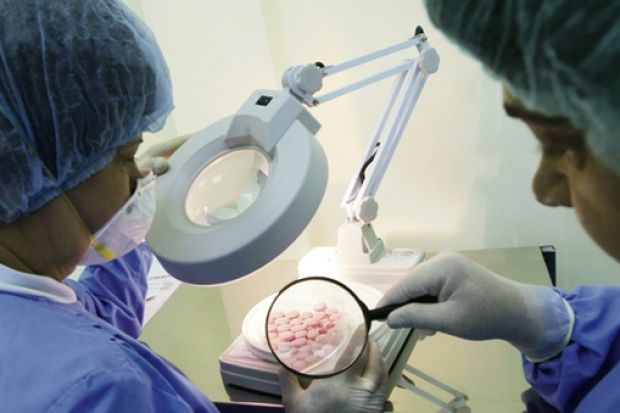The coalition government has "missed a chance to do something radical and deep" with a life science strategy that aims to bring together universities, the NHS and pharmaceutical companies, according to an academic consulted on its development.
The Strategy for UK Life Sciences, announced by Prime Minister David Cameron on 5 December, says that "new models of working between universities, hospitals and businesses need to be developed to place the UK at the forefront of medical research now and in the future".
The strategy includes a £180 million Biomedical Catalyst Fund aimed at helping university researchers and commercial operators to attract private equity funding to commercialise research.
Mr Cameron said that the strategy's proposals to open up patient data for medical research means that "every willing patient is a research patient" - paraphrasing a Times Higher Education article by John Martin, professor of cardiovascular medicine at University College London and adjunct professor of medicine at Yale University ("Healthy, wealthy and wise", 29 September).
In his article, Professor Martin advocated attracting £1 billion from sovereign wealth funds for "high-risk, high-return" projects. The strategy was "a good try", he said this week, "but it doesn't have a big enough vision. It's missed a chance to do something radical and deep."
He added: "In my [THE] article, I suggested that what the government needs to do is put into gear a number of funding sources that it gets from outside the NHS, universities and the pharmaceutical industry by a big plan identifying perhaps 100 projects and funding those properly in a...commercial way with outside funding. That would have made a real difference to UK wealth."
Professor Martin said there should have been more intervention by the government in the organisation of the relationship between the NHS, the universities and industry.
"There is not enough recognition of the creativity of British universities in this," he said. He added: "I like the idea...of every NHS patient being a research patient. This devolves responsibility for healthcare not only to researchers but also to patients themselves.
"I first wrote that down in THE. What is missing, however, is a scheme by which every patient can be a research patient."
The government was also due to announce its research and innovation strategy on 8 December, but details were unavailable at the time of going to press.
Key actions in the life sciences strategy include investing £310 million "to support the discovery, development and commercialisation of research". This covers £130 million for "stratified medicines" - where new drugs may be effective for a small segment of patients with specific genetic characteristics - and £180 million for the Biomedical Catalyst Fund.
The strategy says the latter will tackle the "valley of death" that sees good research ideas fail before they can be brought to market.
Sir Mark Walport, director of the Wellcome Trust, hailed the strategy as "a comprehensive package...that has the potential to transform healthcare innovation in the UK".
He said he was particularly pleased that researchers would be given access to patient information "with appropriate safeguards", which would result in "a step change in patient care and real improvements in the health of the population".
Healthy partnership: a 'new era' of public-private collaboration
A collaboration between the Medical Research Council and pharmaceutical company AstraZeneca has been described as heralding "a new era in medical research".
The company has agreed to make available to academic researchers 22 compounds that it developed to combat specific diseases but abandoned in the late stages of development.
The MRC this week published a detailed list of the compounds - which Sir John Savill, its chief executive, described as "highly targeted molecular probes" - online and is inviting applications from academics to probe their medical efficacy in disease areas that AstraZeneca has not envisaged.
The MRC has set aside £10 million over three years to fund the projects, but Sir John said that figure could rise if it received "really good applications".
He hoped the compounds would encourage researchers to develop their understanding of disease mechanisms in humans, since "we can only go so far with model systems" such as mice.
He also saw the move as part of a general gravitation towards open innovation and public-private collaboration, adding that the MRC and other medical funders around the globe were discussing similar programmes with other pharmaceutical companies.
"We recognise now that there are immense benefits to be had from working with industry and unless we do that we won't make the contribution we might like to economic growth," he said.
Sir John agreed there was a perception that intellectual property was hard to negotiate in such collaborations, but in reality it had been "pretty simple".
Rights to the compounds will remain with AstraZeneca, but universities that develop new patentable techniques will be able to keep the IP, with the company having first refusal on licensing.
Clive Morris, head of new opportunities at AstraZeneca, said he was unaware of any other collaboration with academia that involved no restrictions on the universities involved and diseases investigated.
"It is an experiment in open innovation and turning over a degree of control to the academic world and saying: 'What are the good ideas that are out there?'" he said.
Register to continue
Why register?
- Registration is free and only takes a moment
- Once registered, you can read 3 articles a month
- Sign up for our newsletter
Subscribe
Or subscribe for unlimited access to:
- Unlimited access to news, views, insights & reviews
- Digital editions
- Digital access to THE’s university and college rankings analysis
Already registered or a current subscriber? Login
